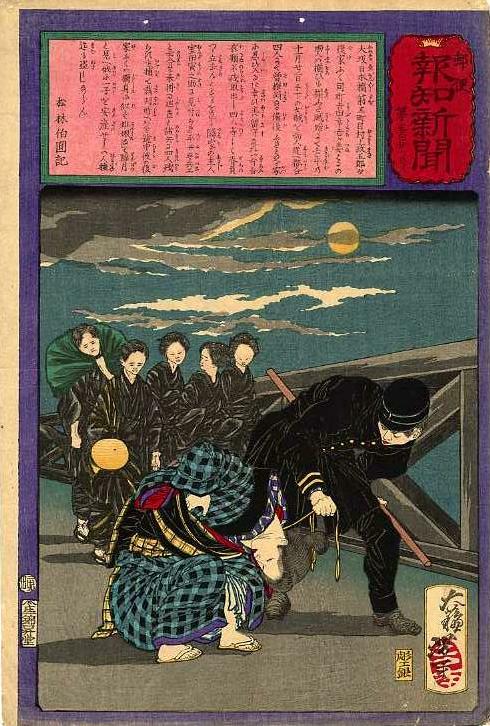No. 527b -- 1874-12-6 Thief gives birth Story translationFuku, the goke [widow] of Murakami Masagoro of Nipponbashi 5-chome in Osaka, and Haru, the wife of Yoshida Kokichi of the same neighborhood, were together a well matched team of thieving women. On the twenty-second day of the eleventh month of last year, they and two underling female thieves, four in all, snuck into the house of Bingo Fuki in Sonezaki. Luckily the master was not there, and they took out all the clothing -- leaving none. Just as the four were loading it equally on their backs and about to depart, they were spotted by Muroda Toranosuke, the master of a neighboring house, who told Hirai Heibei. And together with a patrolman who happened to come by they took the four women alive (ikedorite) -- leaving none. On the way to the court, the goke [widow] Fuku, who unlike a single women was pregnant and looked due, suddenly gave easy birth to a child. So it seems she even stole a man's seed. By Shorin Hakuen [Translated by Mark Schreiber and William Wetherall] Commentary (Andon 80)The newspaper article said that Fuku had become pregnant "although she had no husband" (otto aru mi ni arazaredo), while Hakuen implied that a "single woman" (dokushin) was not expected to be pregnant. Neither version calls Fuku a "widow" (mibōjin, one who has not yet died) but refers to her as a "goke" -- her role as the woman Murakami left in this world to care for his family. Neither expression censures Fuku for not being forever faithful to her deceased husband, a standard of virtue applied to some but not all widows. The newspaper version compared the women to two female thieves of yore -- Mikazuki no Osen and Kijin no Omatsu. Since no violence occurred in the commission of the Osaka crime, such a comparison would appear to be undeserved. While neither version provides details of Fuku and her child's fate, magistrates during the time tended to be lenient with female offenders. Certainly Fuku was nothing like Omatsu, the legendary she-devil of northern Japan, who would entice a samurai to assist her in crossing a river then cut his throat, as depicted in Yoshitoshi's 1886 diptych. [Commentary from Wetherall and Schreiber 2006 in Andon 80] For another story featuring seeds and birth, see TNS-923 Benzo kills Nanigashi. Print informationSeries: Yubin hochi shinbun Principal sourcesYosha Bunko |
